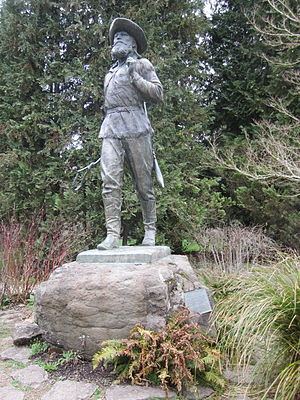Type Sculpture Subject An Oregonian pioneer Opened 22 May 1919 Media Bronze | Medium Bronze Dimensions 4.0 m (13 ft) Created 1919 Year 1919 | |
 | ||
Similar Eugene Pioneer Cemetery, Johnson Hall, Villard Hall, Chapman Hall, Deady Hall | ||
The Pioneer is a thirteen-foot-tall bronze sculpture located on the University of Oregon campus in Eugene, Oregon. It was the artistic work of Alexander Phimister Proctor, commissioned by Joseph Nathan Teal, a Portland attorney. On the day of is unveiling, May 22, 1919, a great ceremony was held complete with playing of the university orchestra. It included attendance from persons all across the state, the majority of enrolled students, and a special section of the crowd was reserved for the remaining pioneers. In fact, a pioneer by the name of T. G. Hendricks and his granddaughter held the honor of removing the canvas cover, unveiling the statue.
Contents
Creation and design
The Pioneer was a long time in the making. Proctor had completed sculptures of pioneer groups, but he searched for a model that would "typify the real spirit of the West." After a ten-year search, he found the image in J. C. Cravens, an "old trapper bewhiskered without a haircut heavy boots thick plants a buckskin coat carrying his rifle and leading a nag." Once he had this model, Proctor took the idea to the Honorable Joseph Teal, a Portland lawyer and businessman, and the sculpture was commissioned. It was the first statue placed on the University of Oregon campus.
The Pioneer is about ruggedness and movement. In form, the sculpture follows attributes of the model with him being portrayed in similar garb, a full beard, and a rifle slung over his shoulder. His body language is proud, as seen in the set of his shoulders and the level of his chin. Further, his open stance implies movement, with his eyes gazing forward and his weight seeming to be in the process of shifting from one foot to the next. The natural, hard organic sentiment flows all the way to his rock pedestal. The basalt was "one that had weathered many storms and had been tossed about by the river currents yet enduring ... [Proctor] thought it was in keeping with the ideals of the Pioneer who had weathered similar storms." In his form, he is the intrinsic strength, prepared to move forward and meet what comes.
Location
His location was chosen with care, both in its general location and in its specific spot. While the bronze was cast from a plaster form in Rhode Island and its trip to Oregon took over a month by train, it made the journey for good reason. When Proctor gave his presentation address of the sculpture he said:
"It is sufficient to say that here the Willamette and McKenzie rivers join their waters into one grand channel and create this beautiful valley, the paradise to which the pioneer struggled over great mountains and across desert plains to which he first came in numbers, and in which he made home. No more fitting place than the campus of University of Oregon could be found for the memorial."
A committee including Mr. and Mrs. Teal, Dean Ellis F. Lawrence, and Irene Hazard Gerlinger chose its exact physical location. He was placed within the Oregon fir trees facing the Administrative Building between the library (Fenton Hall) and Friendly Hall on the University of Oregon campus. Although he is to embody the western spirit, The Pioneer is situated facing south on this site. This orientation was intentional on the part of the artist to ensure that his front is bathed in the greatest light, which only comes from the southern exposure.
Naming
When this sculpture was created and placed its official name was The Pioneer, not The Pioneer Father. The name "Pioneer Father" only came about after the intentions of the creation of the Pioneer Mother was made public in the late 1920s; it was an edit that provided a means to distinguish between the two sculptures. However, with this change, the original intent was misconstrued or lost altogether. When The Pioneer was unveiled, Joseph Teal said:
"This statue is erected and dedicated to the memory of all Oregon pioneers. It is in no sense personal or individual and it is my earnest wish and hope that this fact may ever be kept in mind." "The pioneer represents all that noblest and best in our history. The men and women who saved the west for this country were animated by the highest motives. They made untold sacrifices and endured hardships of every kind in order that their children might enjoy the fruits of their labor."
It was to be a memorial for all Oregon pioneers, men and women alike.
